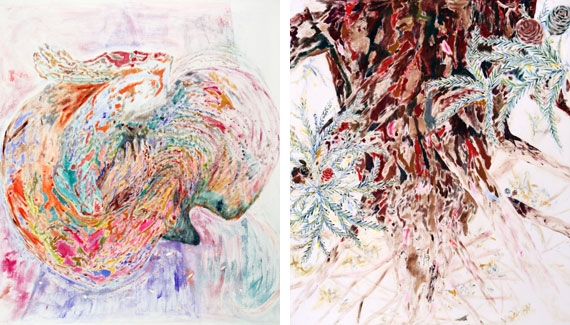
October 27, 2009
ART IS EMBARRASSING
A Tribute to Matthew Offenbacher’s Tribute to His Cat
by Jen Graves
Matthew Offenbacher’s third solo show at Howard House is called C.A.T., after a series of 1917 drawings dubbed “Conventions for Abstract Thoughts” by the artist Charles Burchfield. This show consists entirely of paintings of and about Offenbacher’s cat.
It may sound funny, but it’s not a joke. At a recent talk Offenbacher gave, someone asked him whether he’d ever dreamed of being a standup comedian, and while Offenbacher in person is not at all jokey, the question made a certain amount of sense. The connection is embarrassment.
The new paintings are made on a thin Stainguard fabric that resists the paint, meaning that the paint literally sits uneasily on its surface. This happens on a stylistic level, too. Certain passages resemble the crayon-resist paintings made by grade-school children, while others look like high modernist abstraction (Orphism in particular, which was like cubism plus color and cosmic longing). In the past, Offenbacher has made geometric abstractions that ask you to imagine they were made by beavers, or self-described “repulsive color combinations,” or depictions of owls and wolves patterned after macramé and yarn art. In a 2007 review, I described his work as flirting with the tradition of bad painting, but that’s not quite it: It’s embarrassing painting. There is something deeply embarrassing about Offenbacher’s paintings. They are embarrassed to be paintings–as if it were just an embarrassing thing to be a painting, so fancy and loaded and ambitious–and you are embarrassed to be looking at them, and in this way a connection is made. A house cat may have no shame, but that’s the luxury of the subject of an artwork. The viewer and the artist have no such luxury. We have to wonder what this thing art is, and we have to justify our belief in it. And doing that–explaining a faith in something as insecure as art–is really hard and definitely embarrassing. This is where half-truths, clichés (creative types are just so weird!), and egos come in.
Offenbacher pushes his paintings beyond all this into a sort of awkward, liberating confidence. To proudly present a large painting of your cat’s face upside down on fabric that rejects the paint itself–it is an act of freedom, of perverse strength.
Offenbacher’s art-making is centered on painting but not limited to it–his paintings take up just a corner in the salon he’s invisibly organizing. No other Seattle artist is so unassuming and yet such a power source. He’s not charismatic in any traditional sense–he has floppy, curly hair; boyishly large eyes; and a feminine way about him (he’s straight), like one of those delicate figures hanging out improbably in the corner of a history painting, away from the action–yet he is Seattle art’s community organizer.
Since moving here in 2006 from San Diego, Offenbacher has not only had three solo shows but also organized two substantial group shows with Seattle artists (at Helm Gallery in Tacoma and the back room at Howard House). He has founded, edited, and published five editions of La Especial Norte, a broadsheet zine with essays, porn, and stories by artists living and dead. He has written two terrific long-form essays for La Especial Norte (on “green” gothic and on shit in Northwest art). He recently won Seattle Art Museum’s 2009 Kayla Skinner Special Recognition Award. And now, he is running the defunct gift shop at the Henry Art Gallery as The Gift Shop, an ongoing installation with changing displays that will raise subtle questions about how a place run by artists inside a museum might be different from the rest of the museum.
Offenbacher’s vision for art is one without cults or cliques, but not without dreams. In a letter he wrote in 2005, he described his nostalgia for 1960s ideas about communal living that he remembers from a book of photographs he found at his grandparents’ cottage in Vermont when he was young. “I wanted [my paintings] to show more the possibility for construction, connection, communication, for hope and belief in painting’s transcendent endowments.” In the same letter, he acknowledged, “I mostly wanted these to look sort of familiar, but also strange, alien, off.”
That “off” quality is the essential ingredient in Offenbacher’s work. His curled-up cat painted in a riot of swirling colors exudes eyes-closed bliss and belonging–but the painting is also “strange, alien, off”, streaky, and tentative in places, the cat’s back elongated in an unsightly way. In another painting of the cat sitting upright, its paw is stretched into an oversize, monstrously webby foot. Its eyes, again, are closed. We are made forcibly aware of this alien quality, even though the cat is oblivious. Painting is a state of mind suspended between doubt and belief. It’s private but public. Bringing private and public together, wanting to believe, always means being embarrassed. But what’s the alternative?

NONABSTRACT THOUGHTS: The cat’s name is Turtle. He once got stuck in a tree.